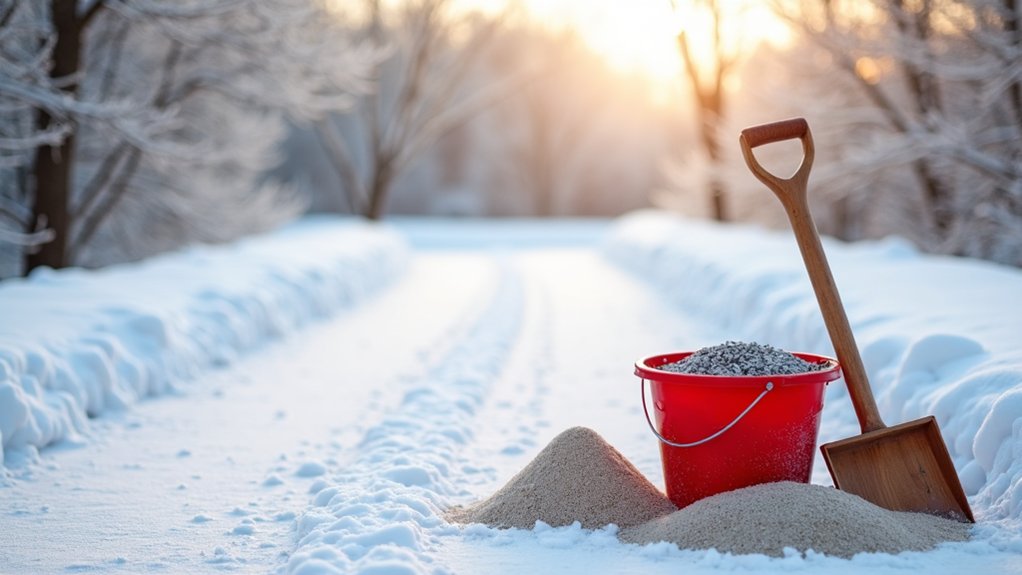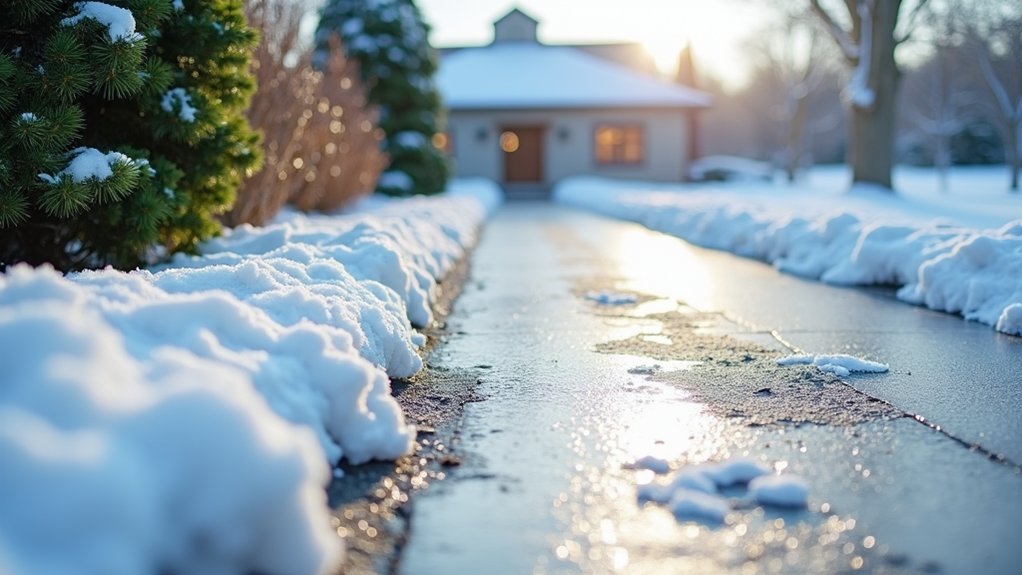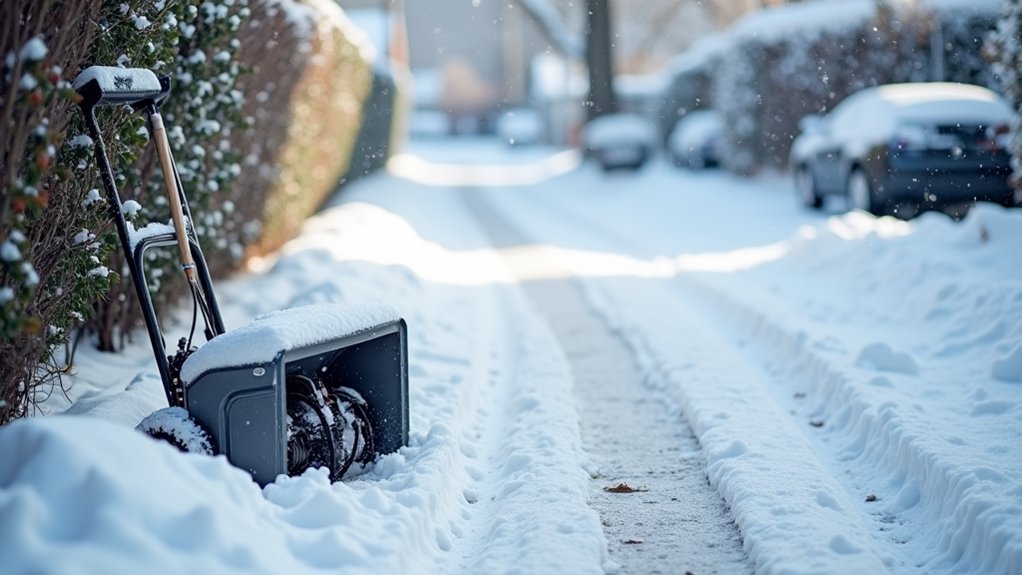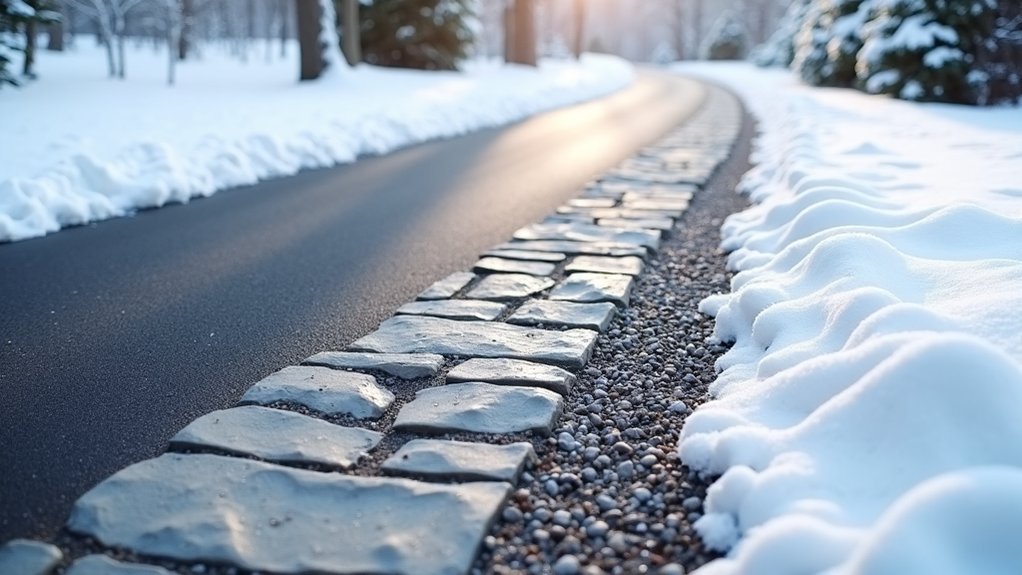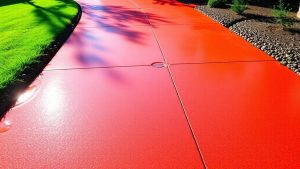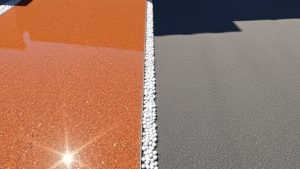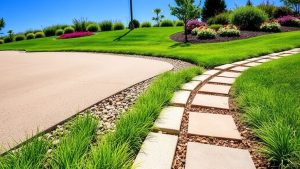To keep your driveway free of ice without using chemicals, consider natural de-icers such as a mix of vinegar and water or baking soda. Wood ash can provide traction, and opting for porous paving can improve drainage. Regularly shovelling snow will help prevent ice build-up, and it’s wise to check for any drainage issues before winter sets in. You might also want to think about heated driveways for added convenience. Explore effective DIY methods and eco-friendly alternatives to traditional de-icers to ensure a safer winter.
Table of Contents
ToggleKey Takeaways
- Mix vinegar and water, or use baking soda to lower the freezing point of ice without harmful chemicals.
- Use wood ash or sawdust for natural traction to prevent slipping on icy surfaces.
- Ensure proper grading and drainage to direct water away from your driveway, which helps reduce ice formation.
- Remove snow promptly after it falls to limit the chance of ice forming underneath.
- Consider installing permeable paving or a gravel overlay to improve drainage and minimise ice build-up.
Natural De-Icing Solutions

When winter arrives and ice starts to cover your driveway, natural de-icing solutions can make a real difference. A simple mix of vinegar and water can lower the freezing point of ice, making it easier to clear away. Additionally, using rubbing alcohol diluted with water is effective and safe for natural stone surfaces. Baking soda is another effective option, as it melts ice without harming your plants or pets. Wood ash can provide traction and slightly reduce ice formation.
For seasonal storage, keep ingredients like leftover coffee grounds, alfalfa meal, and kosher salt handy. They’re eco-friendly and cost-effective. Just be sure to use these methods safely to protect your plants and concrete surfaces. By choosing natural de-icing solutions, you can enjoy the winter while being kinder to the environment.
Preventive Measures for Ice Prevention
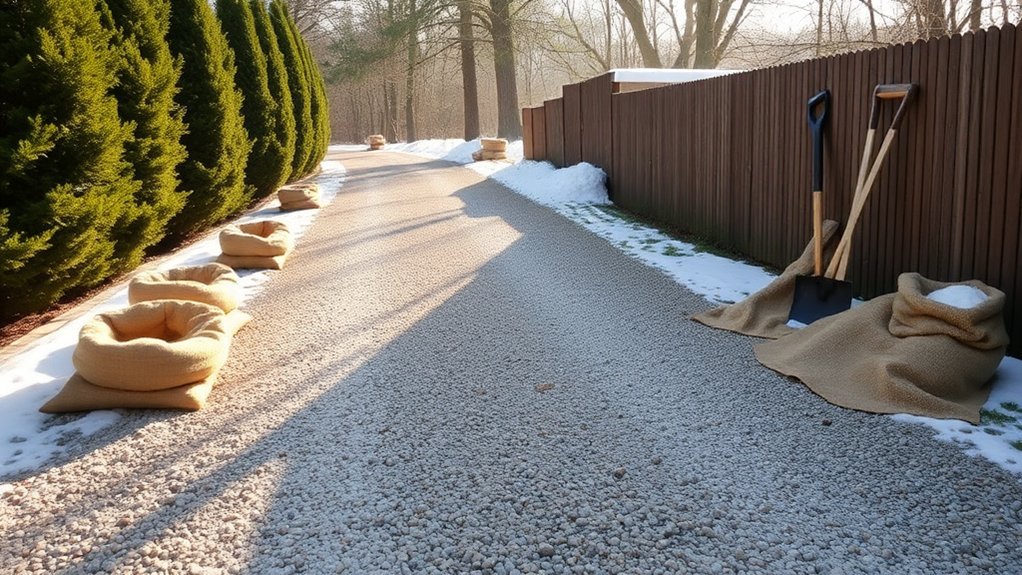
To effectively prevent ice from forming on your driveway, it’s essential to combine structural improvements and regular maintenance.
Start by ensuring proper grading and sloping to direct water away from the surface, and consider using permeable paving for better drainage. Adding a layer of gravel or crushed stone can further enhance drainage and help reduce ice build-up. Additionally, installing resin bound driveways can significantly improve water drainage and minimize ice formation during winter months. Neglecting deicing can lead to larger issues, so be proactive in your maintenance efforts.
Regularly check for cracks and uneven areas to prevent water pooling.
For landscaping, trim overhanging branches and plant evergreens at a safe distance to let in more sunlight.
It’s also important to remove snow immediately after it falls to minimize the risk of ice formation.
Heated Systems for Driveway Maintenance
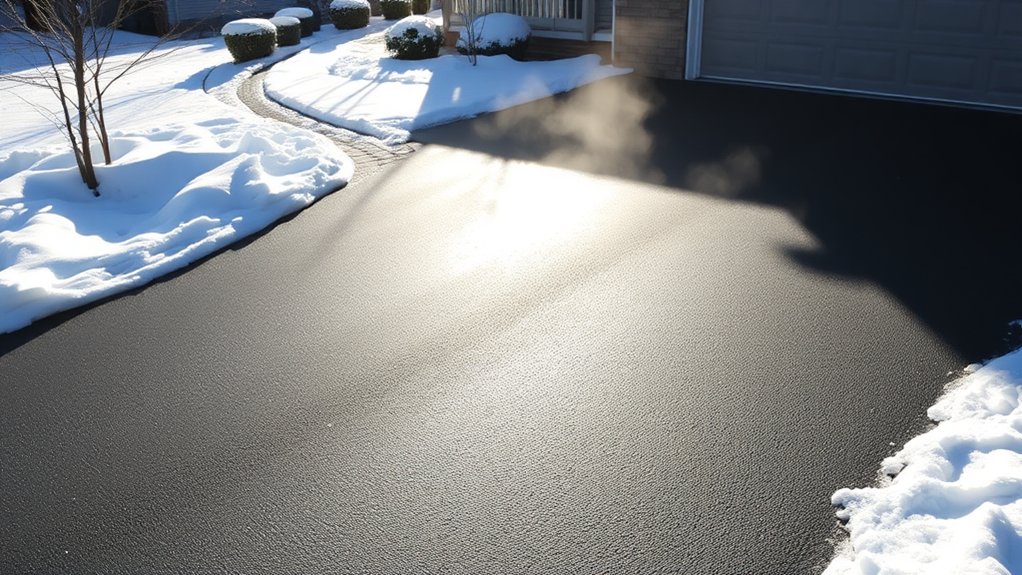
Heated driveway systems provide an effective way to keep your driveway clear of ice and snow, making winter much easier to manage.
Here are three important points to consider:
- Installation Costs: Installation typically costs between £12 and £28 per square foot, depending on the materials and heating system you choose.
- System Types: Electric systems are generally cheaper to install, while hydronic systems can be more cost-effective in terms of running expenses over time. Additionally, the average cost of a new driveway ranges from $2,526 to $7,294, making it a viable option for many homeowners.
- Maintenance: Regular maintenance checks are essential to ensure your heated system operates efficiently, improving safety and potentially increasing your property’s value.
Investing in a heated driveway can significantly enhance your winter experience, providing both convenience and peace of mind.
Enhancing Traction Without Chemicals
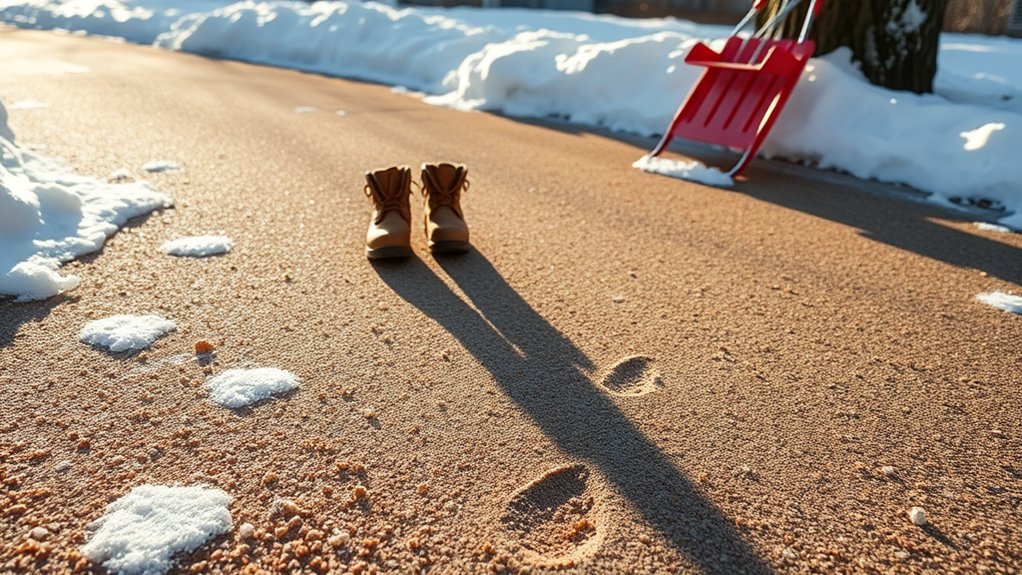
Maintaining a safe, ice-free driveway doesn’t have to involve chemicals. A practical solution is to install a gravel overlay, which creates a textured surface for better traction.
You might also consider using permeable pavers; they allow water to drain away, helping to prevent ice formation. Using local or recycled materials can provide a naturally grippy surface as well. Additionally, permeable driveways contribute to stormwater management by reducing runoff and enhancing groundwater recharge.
For added grip, polished stone or brick pavers can be effective. Natural traction agents like wood ash and sawdust offer excellent alternatives, providing temporary grip without environmental harm.
Lastly, products such as Traction Magic can give you instant traction. By implementing these methods, you can keep your driveway safe and slip-resistant without resorting to harsh chemicals.
Effective Snow Management Techniques
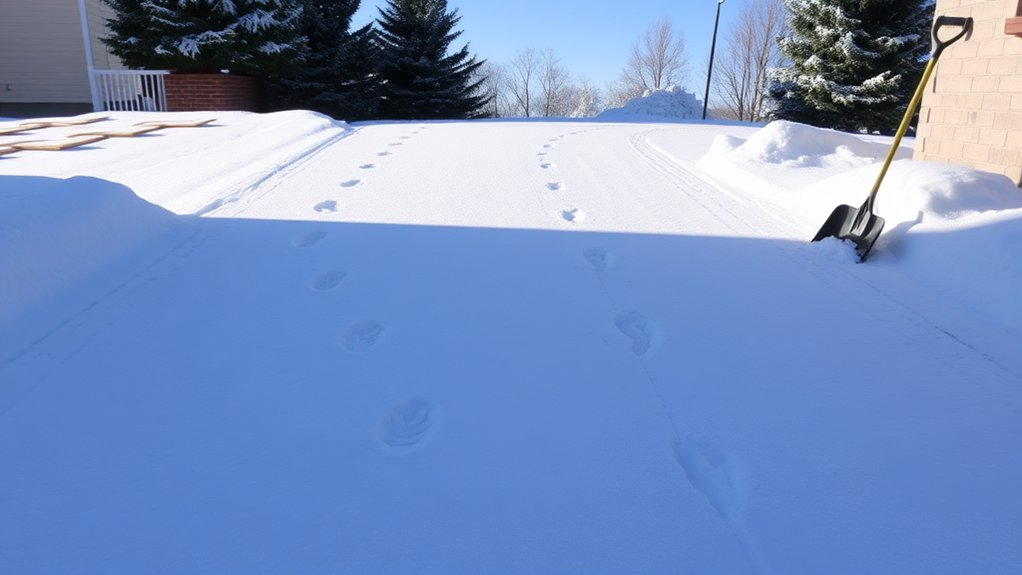
When snow begins to build up, effective snow management techniques are essential for keeping your driveway safe and accessible.
Here are three strategies to consider:
- Plan Ahead: Before snow arrives, check your driveway for any drainage problems and map out a snow removal route to make the job easier.
- Regular Clearing: Shovel snow frequently to avoid it becoming compacted. Use a sturdy, ergonomic shovel to minimise strain on your back.
- Monitor Conditions: Keep an eye on weather forecasts and set reminders to stay updated on snow accumulation.
Consider pre-treating surfaces with salt to help prevent ice formation.
Eco-Friendly Alternatives to Traditional De-Icers

As winter sets in and icy conditions threaten your driveway, it’s wise to consider eco-friendly alternatives to traditional de-icers.
Materials like sand, gravel, or even cat litter can provide excellent traction without melting the ice, making them safe for both plants and pets.
Natural options like sugar beet juice or pickle brine can lower the freezing point of water and are less harmful to waterways.
For a DIY solution, a simple mix of vinegar and water can work as a gentle de-icer.
Use these eco-friendly methods sparingly to reduce environmental impact.
DIY Chemical-Free De-Icing Methods
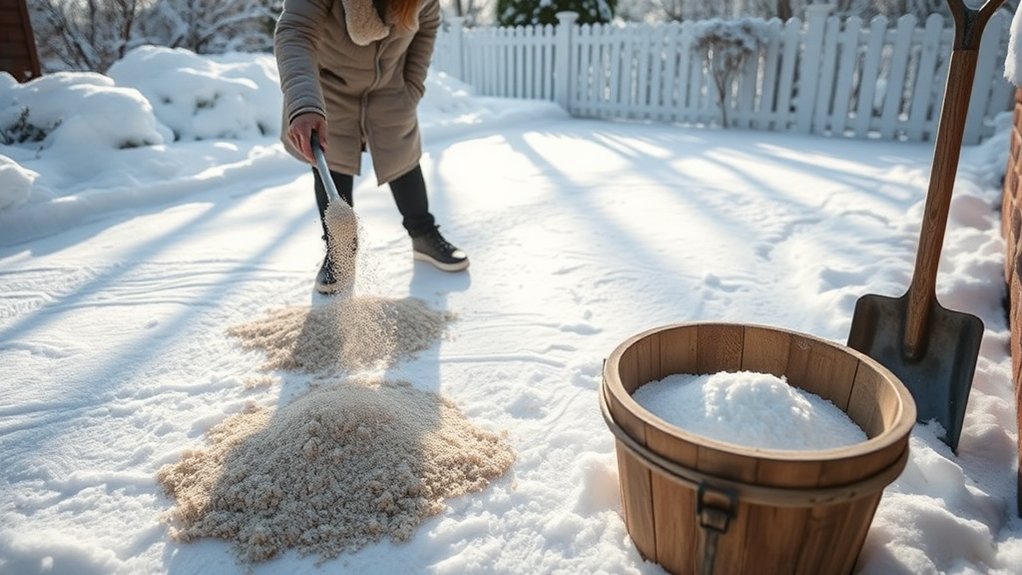
If you’re after effective, chemical-free ways to de-ice your driveway, try a vinegar and water solution, a baking soda mix, or a rubbing alcohol blend.
These DIY methods melt ice while being kinder to the environment than traditional de-icers. They’re simple to prepare and apply, ensuring your driveway stays safe without the use of harmful chemicals.
Vinegar and Water Solution
Vinegar and Water Solution
Many traditional de-icers can damage the environment, but a vinegar and water solution is an effective, eco-friendly alternative for keeping your driveway free from ice.
Vinegar lowers the freezing point of water, making it great for melting ice. Here’s how to use it:
- Mix: Combine equal parts vinegar and water for thin ice, or a stronger mix of two parts water to three parts vinegar for thicker ice.
- Apply: Use a spray bottle or pour the mixture evenly over icy areas for the best results.
- Layer: For stubborn ice, apply multiple layers of the solution.
Be cautious with the amount used, as vinegar’s acidity can damage certain surfaces over time.
Baking Soda Mixture
Baking soda is a versatile and eco-friendly option for de-icing your driveway, offering a natural solution that’s effective and safe. It lowers the freezing point of water, which helps melt ice, although it works more slowly than rock salt.
To use it, simply sprinkle baking soda generously along your driveway before ice forms, especially if an overnight freeze is expected. For better traction, consider mixing baking soda with coffee grounds, sand, or cat litter.
Allow at least 15 minutes for the baking soda to start melting the ice. This non-corrosive alternative won’t harm surfaces or pollute waterways, making it safe for pets and plants.
Planning ahead is essential for the best results, so make sure you’re prepared in advance.
Rubbing Alcohol Blend
A simple and effective DIY method for keeping your driveway free from ice is to use a rubbing alcohol blend. This homemade deicer has several advantages:
- Cost-Effective Solution: Mix 2 parts rubbing alcohol with 1 part warm water for an economical alternative.
- Enhanced Formula: For improved results, combine half a gallon of hot water, six drops of dish soap, and 1/4 cup of rubbing alcohol.
- Easy Application: Use a spray bottle to apply evenly on driveways, pavements, and car windscreens.
While rubbing alcohol mightn’t melt ice as quickly as salt, it’s gentler on your surfaces and helps prevent refreezing.
Just be sure to test the mixture on a small area first to protect any nearby plants or grass.
Frequently Asked Questions
What Are the Best Times to Apply Natural De-Icers?
To achieve the best results, apply natural de-icers before snowfall as a preventive measure. If you need to use them after snow has fallen, pay attention to the temperature. This ensures that the conditions are right for the de-icer to work effectively.
How Can I Tell if My Driveway Is Properly Sealed?
To determine if your driveway is properly sealed, start with a quick surface check for any cracks or fading. This will help ensure the longevity of the sealant. Look for a consistent colour and smooth texture, as these indicate an even application and effective protection against damage.
Are Heated Systems Energy-Efficient in Cold Climates?
Heated systems, such as heated mats, are generally energy-efficient in cold climates. They conserve energy by only activating when needed, significantly lowering overall consumption while effectively preventing snow and ice from accumulating on your driveway.
What Are the Best Materials for Snow Storage Areas?
When selecting materials for snow storage areas, opt for those that promote snow retention and provide effective drainage. Asphalt and permeable paving stones are excellent choices, as they help manage snow efficiently and minimise ice formation, making driveways safer and more durable.
Can I Use Vinegar on All Driveway Surfaces?
You can use vinegar on most driveway surfaces as it’s effective at melting ice. However, be careful; its acidity can gradually erode concrete. Always test a small area first to ensure there’s no damage.
Conclusion
Keeping your driveway free of ice without using chemicals not only protects your vehicle but also benefits the environment. Employing natural de-icing methods, preventive strategies, and effective snow clearing can save you both time and effort. For instance, using sand or gravel can improve traction, while heated mats can melt ice without harmful substances. So, grab your snow shovel and tackle winter in an eco-friendly way—step by step!
Be proactive in protecting your driveway from cold weather cracks by learning essential sealing techniques that could save you costly Read more
Achieve a pristine tarmac driveway this winter—discover the best snow removal methods that will keep your surface safe and clear.
Uncover the ideal driveway material for frigid temperatures and discover which option can withstand winter's harshest challenges effectively.

